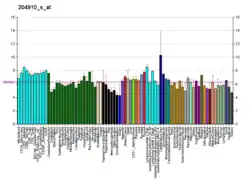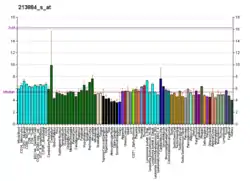TRIM3
Tripartite motif-containing protein 3 is a protein that in humans is encoded by the TRIM3 gene.[5][6]
| TRIM3 | |||||||||||||||||||||||||||||||||||||||||||||||||||
|---|---|---|---|---|---|---|---|---|---|---|---|---|---|---|---|---|---|---|---|---|---|---|---|---|---|---|---|---|---|---|---|---|---|---|---|---|---|---|---|---|---|---|---|---|---|---|---|---|---|---|---|
| Identifiers | |||||||||||||||||||||||||||||||||||||||||||||||||||
| Aliases | TRIM3, BERP, HAC1, RNF22, RNF97, tripartite motif containing 3 | ||||||||||||||||||||||||||||||||||||||||||||||||||
| External IDs | OMIM: 605493 MGI: 1860040 HomoloGene: 21290 GeneCards: TRIM3 | ||||||||||||||||||||||||||||||||||||||||||||||||||
| |||||||||||||||||||||||||||||||||||||||||||||||||||
| |||||||||||||||||||||||||||||||||||||||||||||||||||
| |||||||||||||||||||||||||||||||||||||||||||||||||||
| |||||||||||||||||||||||||||||||||||||||||||||||||||
| |||||||||||||||||||||||||||||||||||||||||||||||||||
| Wikidata | |||||||||||||||||||||||||||||||||||||||||||||||||||
| |||||||||||||||||||||||||||||||||||||||||||||||||||
The protein encoded by this gene is a member of the tripartite motif (TRIM) family, also called the 'RING-B-box-coiled-coil' (RBCC) subgroup of RING finger proteins. The TRIM motif includes three zinc-binding domains, a RING, a B-box type 1 and a B-box type 2, and a coiled-coil region. This protein localizes to cytoplasmic filaments. It is similar to a rat protein which is a specific partner for the tail domain of myosin V, a class of myosins which are involved in the targeted transport of organelles. The rat protein can also interact with alpha-actinin-4. Thus it is suggested that this human protein may play a role in myosin V-mediated cargo transport. Alternatively spliced transcript variants encoding the same isoform have been identified.[6]
Interactions
TRIM3 has been shown to interact with Actinin alpha 4.[7]
TRIM3 binds to and ubiquitinates Estrogen receptor alpha (ERa) leading to receptor's stabilization.[8]
Moreover, TRIM3 interacts with P53 which promotes the formation of K48-linked poly-ubiquitin chains and degradation.[9]
References
- GRCh38: Ensembl release 89: ENSG00000110171 - Ensembl, May 2017
- GRCm38: Ensembl release 89: ENSMUSG00000036989 - Ensembl, May 2017
- "Human PubMed Reference:". National Center for Biotechnology Information, U.S. National Library of Medicine.
- "Mouse PubMed Reference:". National Center for Biotechnology Information, U.S. National Library of Medicine.
- El-Husseini AE, Vincent SR (July 1999). "Cloning and characterization of a novel RING finger protein that interacts with class V myosins". The Journal of Biological Chemistry. 274 (28): 19771–19777. doi:10.1074/jbc.274.28.19771. PMID 10391919.
- "Entrez Gene: TRIM3 tripartite motif-containing 3".
- El-Husseini AE, Kwasnicka D, Yamada T, Hirohashi S, Vincent SR (January 2000). "BERP, a novel ring finger protein, binds to alpha-actinin-4". Biochemical and Biophysical Research Communications. 267 (3): 906–911. doi:10.1006/bbrc.1999.2045. PMID 10673389.
- Zhuang T, Wang B, Tan X, Wu L, Li X, Li Z, et al. (April 2022). "TRIM3 facilitates estrogen signaling and modulates breast cancer cell progression". Cell Communication and Signaling. 20 (1): 45. doi:10.1186/s12964-022-00861-z. PMC 8991925. PMID 35392925.
- Wang X, Zhang Y, Pei X, Guo G, Xue B, Duan X, Dou D (November 2020). "TRIM3 inhibits P53 signaling in breast cancer cells". Cancer Cell International. 20 (1): 559. doi:10.1186/s12935-020-01630-z. PMC 7685606. PMID 33292295.
Further reading
- El-Husseini AE, Kwasnicka D, Yamada T, Hirohashi S, Vincent SR (January 2000). "BERP, a novel ring finger protein, binds to alpha-actinin-4". Biochemical and Biophysical Research Communications. 267 (3): 906–911. doi:10.1006/bbrc.1999.2045. PMID 10673389.
- El-Husseini AE, Fretier P, Vincent SR (February 2001). "Cloning and characterization of a gene (RNF22) encoding a novel brain expressed ring finger protein (BERP) that maps to human chromosome 11p15.5". Genomics. 71 (3): 363–367. doi:10.1006/geno.2000.6452. PMID 11170753.
- Reymond A, Meroni G, Fantozzi A, Merla G, Cairo S, Luzi L, et al. (May 2001). "The tripartite motif family identifies cell compartments". The EMBO Journal. 20 (9): 2140–2151. doi:10.1093/emboj/20.9.2140. PMC 125245. PMID 11331580.
- Lee SJ, Choi JY, Sung YM, Park H, Rhim H, Kang S (August 2001). "E3 ligase activity of RING finger proteins that interact with Hip-2, a human ubiquitin-conjugating enzyme". FEBS Letters. 503 (1): 61–64. doi:10.1016/S0014-5793(01)02689-8. PMID 11513855. S2CID 42977319.
- Yan Q, Sun W, Kujala P, Lotfi Y, Vida TA, Bean AJ (May 2005). "CART: an Hrs/actinin-4/BERP/myosin V protein complex required for efficient receptor recycling". Molecular Biology of the Cell. 16 (5): 2470–2482. doi:10.1091/mbc.E04-11-1014. PMC 1087250. PMID 15772161.
- Olsen JV, Blagoev B, Gnad F, Macek B, Kumar C, Mortensen P, Mann M (November 2006). "Global, in vivo, and site-specific phosphorylation dynamics in signaling networks". Cell. 127 (3): 635–648. doi:10.1016/j.cell.2006.09.026. PMID 17081983. S2CID 7827573.






